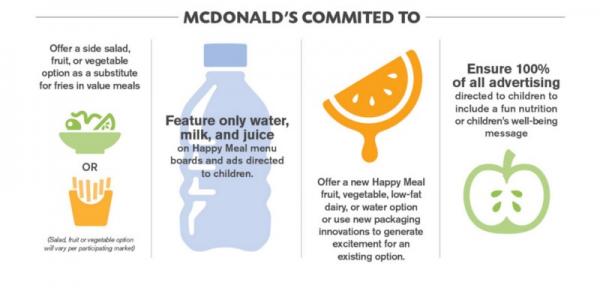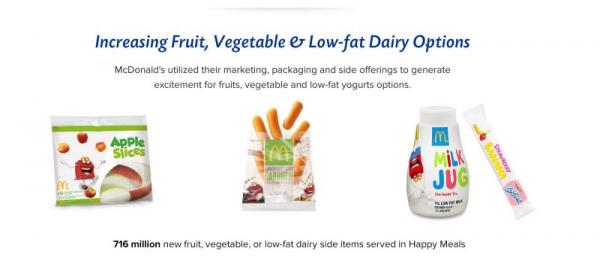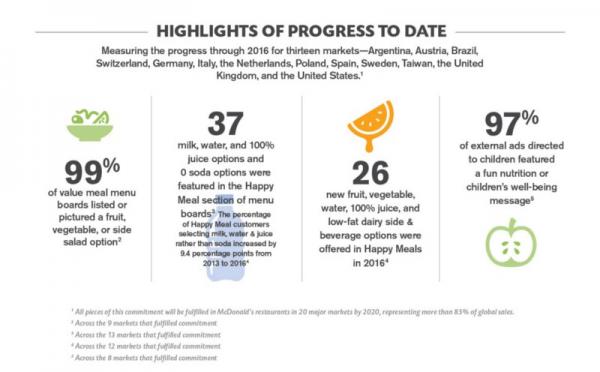September 28, 2017
Fruit, Veggies & Low-Fat Dairy: Tracking McDonald’s Efforts to Serve Healthier Options to Families
Whether it is offering cherry tomatoes in Brazil, carrots in Spain or lower-sugar Go-Gurt Yogurt in the United States McDonald’s has taken important steps to increase access to healthier food and drink options for families.
Originally announced in 2013, our partnership with McDonald’s is rooted in the belief real change comes from collaboration between non-profits and the business sector. To understand the impact of our partnership, we are intentional about having measurable metrics that are meaningful, attainable, and tracked regularly.
The latest progress report for the McDonald’s-Healthier Generation partnership, shows McDonald’s continues to meet or exceed its commitments to Healthier Generation. What does this really mean? It means more families have access to fruit, vegetables, low-fat dairy and reduced sugar products. Here are a few examples of the immense impact resulting from these changes:
- 951 million water, fruit, vegetable, 100% juice, and low-fat dairy items were served in Happy Meals across the 13 markets in 2016.
- 716 million new fruit, vegetable, or low-fat dairy side items were served in Happy Meals and a la carte across 13 participating markets between 2014 and 2016.
- The percentage of Happy Meal customers selecting milk, water & juice rather than soda increased by 9.4 percentage points across twelve markets from 2013 to 2016.
We are excited to continue to track the progress of our partnership and shine a spotlight on the powerful role McDonald’s plays in creating healthier environments for kids and families, not only here in the U.S. but also around the globe.
While we encourage you to read the comprehensive interactive 2016 Progress Report, we also asked Robert F. Wescott, President & Founder of Keybridge and Brendan Fitzpatrick, Senior Director to share their perspective on this latest milestone progress report.
Q: Why is evaluation important in the context of an initiative like the McDonald’s-Healthier Generation Partnership?
A: As an independent third-party evaluator, our core responsibility is to measure and report progress from an objective viewpoint. We’ve found that this objective analysis and reporting serves three purposes that contribute to the success of voluntary initiatives. The primary purpose is establishing accountability to fulfill a commitment. While this may be the most commonly understood purpose of evaluation, evaluation also helps commitment signatories to implement the commitments by providing feedback on their successes and trouble areas. Finally, our evaluations aim to identify the broader impact of such an initiative on customers and society.
Q: How does Keybridge help to establish that level of accountability?
A: We have been evaluating and reporting on industry agreements for the past dozen years. We believe that an important part of the success of agreements like the McDonald’s-Healthier Generation Partnership has to do with a strong commitment to rigorous and transparent monitoring and public reporting. Keybridge’s role as an independent third party evaluator is to objectively examine and measure the progress made toward goals, build a body of irrefutable evidence to support our conclusions, and publicly report the results. When this system is in place, everyone can see the results for themselves, and the signatories are publicly accountable for the fulfillment of their commitments.
Q: How can an evaluation process improve implementation through the course of an initiative?
A: Transparency is a cornerstone of voluntary agreements. For this initiative, one of the ways that McDonald’s and Healthier Generation established transparency was by setting key check-in points to report on progress toward interim goals, such as the 2016 goals discussed in the report that we just released. Beyond updating the public on their progress, this process has the added benefit of generating a continuous stream of information which serves as an early alert system for unexpected challenges and emerging best practices. For example, as part of our verification, we have local customers visiting restaurants as “mystery shoppers” all over the world. If we see something in their photo evidence that might impact the success of the commitments — such as a restaurant displaying an outdated menu board, or a particularly innovative promotion for a fruit or vegetable item — we are able to share these insights. This information gives individual markets an opportunity to course-correct and to learn about the interesting ways other markets are achieving the commitment goals.
Q: You mentioned that one of the goals of evaluation is to understand the impacts on consumers and society. Which activities related to the McDonald’s-Healthier Generation Partnership have shown the greatest impact so far?
A: It is important to understand and communicate not just whether a commitment was fulfilled, but what that means. This can be challenging when trying to tie a specific action to a change in customer behavior. This is partially because customer behavior is complex, but also because this initiative includes many actions that impact many areas of the customer experience at the same time. For example, it is impossible to know whether a particular customer selected milk instead of soda in their meal because milk was featured in a Happy Meal ad, because it had attractive packaging with a brand character, because it was listed first on the menu, or some other reason. However, one action that can be convincingly linked to an impact is the removal of sodas from kids’ meal menus. In many markets, this was an abrupt change in how beverage options were shown, and the date of the menu change corresponded with sharp accelerations in the percentage of people who chose milk, water, or juice — the beverages remaining on the menu boards. We observed this same pattern in many markets.
Q: Tracking multiple commitments across different global markets sounds complex. How do you get the information you need and verify the data?
A: The five commitments of the McDonald’s-Alliance partnership are all very different, covering topics as diverse as television advertising and fruit and vegetable menu offerings. Each commitment requires a different strategy for data collection and corroboration. For example, we can verify Happy Meal offerings using photos of menu boards, Happy Meal purchases by “mystery shoppers”, and sales data. We verify the messages in television ads directed to children using video files provided by McDonald’s, ad placement data provided by McDonald’s media firm, and syndicated data identifying the audience composition for the programs on which ads were placed.
As described in our methodology, these two examples use a strategy of triangulation: collecting data from multiple sources to corroborate results. Because there is no definitive public data source to indicate progress on these commitments, we use McDonald’s-reported data to identify the specific activities undertaken by McDonald’s in each market to implement the commitments, and we use external data sources to confirm that McDonald’s restaurants and ad agencies implement those actions. This strategy ensures confidence in and credibility of our results, while allowing us to tell the full story of how these goals are being accomplished.
Q: Based on your analysis of the data, which commitment has seen the most progress and what commitment has the most room for improvement?
A: One area where we’ve seen significant change is in the implementation of commitment 1 — featuring only milk, water, and juice on menu boards, in-store ads directed to children, and external advertising directed to children. Before the McDonald’s-Alliance partnership, nearly all of the 13 markets that we have verified so far featured soda on Happy Meal menu boards. Now, none of them do.
While the challenge of implementing each commitment varies by market, we have seen that commitments requiring one-time actions, like menu board changes, have had more rapid progress than commitments that require ongoing actions such as the goal of including a fun nutrition or children’s well-being message in all external ads directed to children. The initial setting of interim goals for 2016 and 2018 factored in these differences, requiring more markets to make early progress on certain commitments than on others. Our report shows that the interim goals for all five commitments were met or exceeded in 2016.
Q: As part of this report you measured progress across 13 different countries through 2016. What are some of the interesting differences you see across them?
A: The markets participating in the verification effort have a lot of diversity in terms of offerings, restaurant setup, advertising strategies, supply chains, and more. Commitment 3 (Happy Meal innovations) is an interesting example, in that it shows the different types of new Happy Meal offerings that markets selected. 26 new fruit, vegetable, low-fat dairy, and water options were introduced across 12 markets since the partnership was announced in 2013. These options are as different as a corn cup in Taiwan, fruit puree in Switzerland and Germany, and mango in Spain. Markets also differ in whether they offer these options seasonally or year-round, how they package them, and which options are most popular based on local preferences. The commitments give markets the flexibility to innovate and choose culturally appropriate strategies. The resulting diversity of strategies is quite interesting.
Q: Keybridge describes itself as being at the forefront of “public policy economics”. What do you mean by that and how does it relate to your evaluation of these particular commitments?
A: A lot of the changes that we have seen in the food and beverage industry have started with discussions between non-profit organizations like Healthier Generation and major companies like McDonald’s who voluntarily make changes that can change practices industry-wide. For example, since McDonald’s announced that it would remove sodas from Happy Meal menus, many other major quick-service restaurant chains, like Burger King, Wendy’s, Dairy Queen, Applebee’s, and Jack in the Box have followed suit.
Just like good regulatory and law-making processes must be informed by rigorous scientific and economic analysis, so too is the policymaking that is happening in the McDonald’s board room. Our analysis has helped establish that the commitments that were made are being adopted and are having an impact.
Q: What will you be watching in this initiative looking toward 2020 and beyond?
A: McDonald’s and Healthier Generation are well on the way to fulfilling the commitments made in their partnership, particularly in terms of providing options and increasing access to fruits, vegetables, low-fat dairy, and water. Looking forward, now that the options are available, the challenge will be to continue getting more customers to choose these items. This partnership is taking place in a marketplace that is evolving quickly, and it will be crucial to maintain excitement and continue increasing consumer awareness to maximize the positive impact of these commitments.




